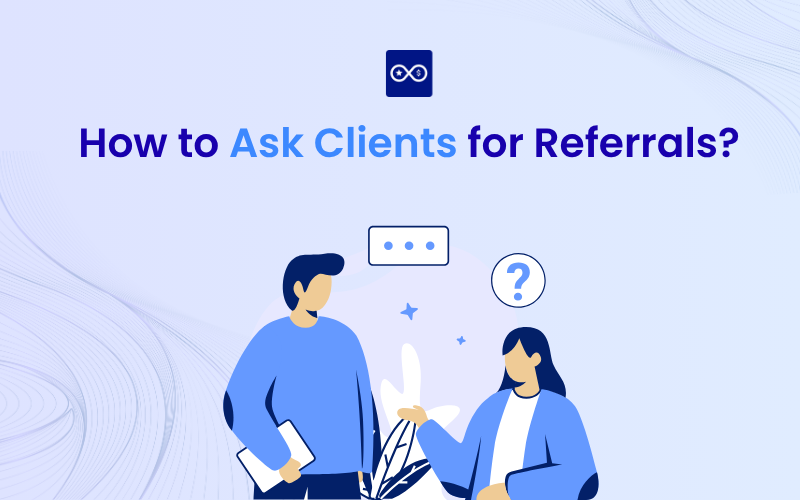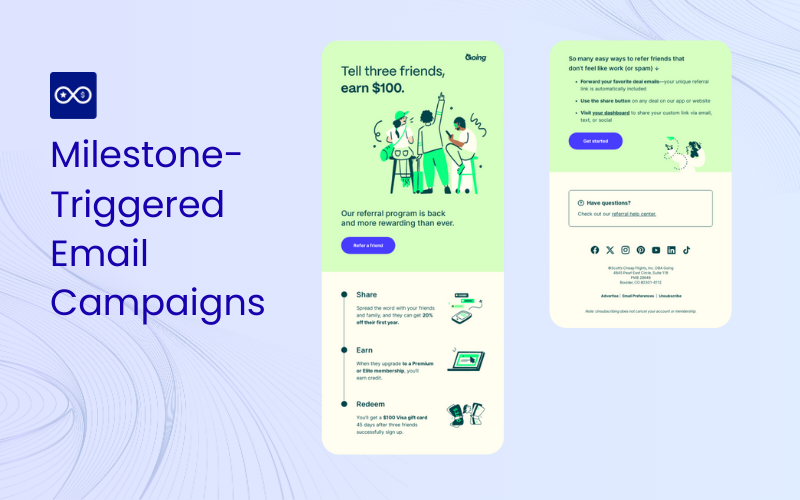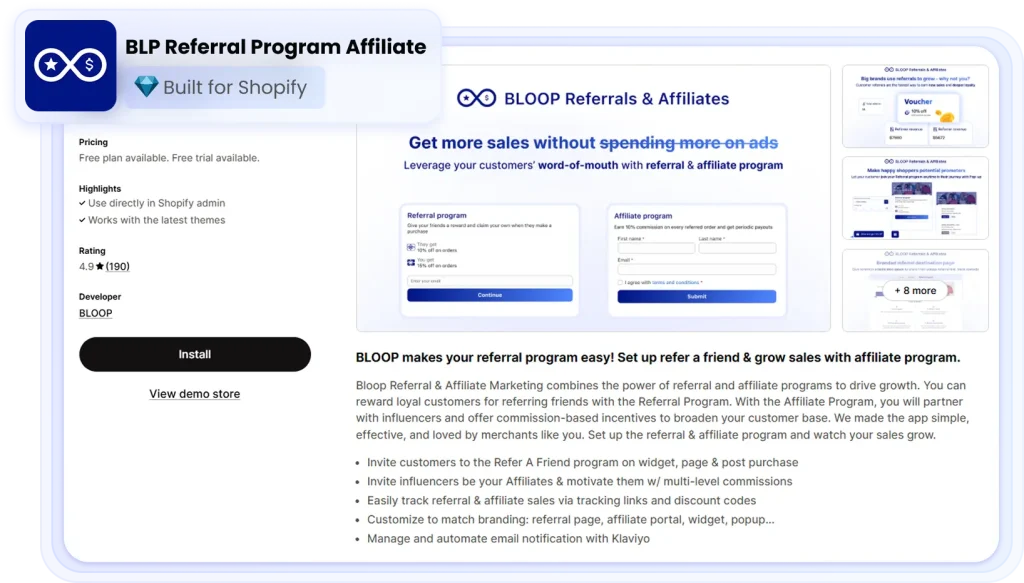How to Ask Clients for Referrals: 50 Proven Tips for Shopify Merchants

Your best customers already want to tell their friends about your store, they just need the right nudge at the right moment. Most Shopify merchants leave this growth channel untapped because they’re unsure how to ask without sounding desperate or pushy.
The difference between a referral program that generates consistent revenue and one that gets ignored comes down to timing, messaging, and making the process effortless. This guide walks through when to ask, exactly what to say, and how to set up a system that turns happy customers into your most effective marketing channel.
>> You may also like:
- 10 Best Ways to Promote Referral Links Free for Shopify Stores
- Referral Program Best Practices for Shopify Stores (with 10+ Examples and a Free Template)
- How to Set Up a Referral Program on Shopify? (With Excel Checklist)
Why client referrals matter for Shopify growth?
The most effective way to ask for a referral is to build value first, time your request when satisfaction peaks, and make the process effortless for your customer. For Shopify merchants, this typically means sending a follow-up email after a successful purchase, offering a clear incentive, and providing a personalized message with a one-click referral link.
Referrals work because they come from trusted sources rather than advertisements. When a friend recommends your store, their endorsement carries more weight than any paid ad campaign. Referred customers tend to have higher lifetime values, lower acquisition costs, and better retention rates than customers acquired through other channels.
The economics tell a clear story. While paid ads on Facebook or Google can cost $30-$50 per customer acquisition, referral programs typically cost a fraction of that, often just the value of a discount code or store credit. You’re essentially turning your existing customers into a sales force that operates on performance-based compensation.
Beyond the numbers, referrals create a compounding growth effect. Each new referred customer becomes a potential advocate themselves, creating a self-sustaining cycle. This word-of-mouth engine becomes particularly valuable during economic downturns when advertising budgets tighten.
When and who to ask for a referral?
Timing determines whether your referral request feels natural or pushy. The ideal moment to ask is when a customer’s satisfaction is at its peak, right after they’ve received their order, resolved a support issue, or expressed enthusiasm about your product.
Not all customers make equally good advocates. Your best referral sources are customers who have purchased multiple times, engaged with your brand on social media, or left positive reviews.

Post-purchase thank-you page
The moment immediately after checkout captures customers when their excitement is highest. Adding a referral widget to your order confirmation page lets you capitalize on this enthusiasm while the purchase is still fresh in their mind. This approach works particularly well because customers haven’t yet experienced potential issues like shipping delays or product concerns.
NPS promoter follow-up
Net Promoter Score (NPS) surveys ask customers how likely they are to recommend your store on a scale of 0-10. Anyone who rates you a 9 or 10 is classified as a “promoter”—your natural advocates. Following up with promoters within 24-48 hours of their positive rating creates a logical conversation flow.
Loyalty milestone emails
Celebrating customer milestones creates natural opportunities for referral requests. Milestones might include a customer’s first anniversary with your brand, their fifth purchase, or reaching a certain spending threshold. The celebration context makes the referral ask feel like an invitation to share something special rather than a sales pitch.

VIP customer DMs
Your top-spending customers often respond better to personalized outreach than automated emails. Sending a direct message on Instagram or a personal email from a founder creates a relationship-building moment that feels authentic. This approach works best when you reference specific purchases or interactions.
Post-support satisfaction surveys
Successfully resolving a customer service issue often creates more loyalty than if the problem had never occurred. Customers who receive exceptional support frequently become vocal advocates because you’ve demonstrated reliability under pressure. Following up within hours of resolving an issue, while the positive experience is still top of mind, turns gratitude into action.
How to ask for a referral without feeling pushy?
The difference between an effective referral request and an uncomfortable one comes down to framing. Instead of asking customers to help you make sales, position referrals as helping their friends discover something valuable. Leading with the relationship rather than the transaction changes the entire dynamic.
Personalize the message
Generic referral requests get ignored. Using the customer’s name, mentioning their specific purchase, and acknowledging their relationship with your brand transforms a mass email into a personal conversation. For example, “Hi Sarah, we’re so glad you loved the ceramic planter set” lands differently than “Dear Customer.”
Highlight mutual benefit
Double-sided rewards—where both the referrer and their friend receive benefits—remove the awkwardness of asking for a favor. Framing like “Give your friends 20% off and get $20 credit when they purchase” emphasizes the win-win nature. This approach also gives customers a clear value proposition to share rather than asking them to promote you for free.
Keep the ask specific
Vague requests like “refer your friends” are easy to ignore because they require too much mental effort. Specific asks like “know anyone planning a wedding?” or “have friends who love sustainable skincare?” give customers a clear mental search to run. Specificity also helps customers identify relevant people in their network.
Make it ridiculously easy
Friction kills referrals. Every extra step between intention and action dramatically reduces completion rates. Pre-written messages, direct sharing links, and one-click options remove barriers that prevent customers from following through. The best referral systems let customers share via their preferred channel—email, text, social media—without leaving the page or copying-and-pasting codes.
Always offer a genuine thank-you
Whether or not a customer makes a successful referral, acknowledging their consideration builds long-term goodwill. A simple “Thanks for thinking of us” email maintains the relationship regardless of outcome. This approach also keeps the door open for future referrals.
50 proven tips to earn more referrals
The most successful referral programs combine strategic incentives, smart timing, and creative outreach. Here are 50 actionable tactics organized by category.
Incentive design:
- Offer double-sided discounts: Both referrer and referee receive discount codes, creating mutual value
- Test tiered rewards: Increase rewards for multiple successful referrals (1 referral = $10, 3 referrals = $35)
- Surprise with store credit: Unexpected rewards create stronger emotional connections than announced incentives
- Add gamified milestones: Create referral levels with increasing benefits to encourage continued participation
- Provide exclusive early access: Let top referrers preview new products before public launch
- Give physical rewards: Send branded merchandise or product samples to successful referrers
- Offer charity donations: Let referrers choose to donate their reward to a cause instead
- Allow referral stacking: Let customers combine referral credits with other discounts
Timing triggers:
- Embed in shipping notifications
- Time seasonal campaigns around holidays
- Target repeat purchasers after second or third order
- Follow up within 24 hours of positive reviews
- Include QR codes in product packaging
- Send after customer service wins
- Trigger based on purchase value over $100
- Automate in third or fourth welcome email
Communication channels:
- Hand-write thank-you notes in packages
- Use SMS for high-value customers
- Create shareable social content
- Add referral pop-ups at checkout
- Include in email signatures
- Build a dedicated referral landing page
- Show referral program ads to existing customers on social media
- Feature customer stories in newsletters
Program mechanics:
- Reward first-time referrers with bonus amounts
- Set expiration dates to create urgency
- Offer flexible redemption on any product
- Create referral partnerships with complementary brands
- Host limited-time referral contests
- Build ambassador programs for top referrers
- Display referral statistics like “1,247 customers have shared”
- Add social sharing buttons for one-click posting
Advanced tactics:
- A/B test subject lines
- Test different reward amounts
- Segment offers by customer type
- Track which channels drive conversions
- Survey non-participants to identify barriers
- Use predictive analytics to identify likely referrers
- Implement fraud prevention for self-referrals
- Personalize reward types (discounts vs. credits vs. free products)
- Create seasonal variations in rewards and messaging
- Test different CTAs like “Refer a Friend” versus “Share the Love”
- Integrate with loyalty programs for point awards
- Connect to customer service tools for agent prompts
- Sync with email platforms for segmentation
- Feature UGC from referrers on social media
- Offer graduated rewards that increase with volume
- Create VIP referral tiers with exclusive perks
- Build affiliate hybrid programs for influencers
- Use retargeting ads for program awareness
Referral email template library for Shopify merchants
Effective referral emails balance enthusiasm with clarity. The following templates provide starting points you can customize for your brand voice.
New customer referral email template
Subject: Welcome gift inside—share it with a friend
Hi [First Name],
Thanks for your recent order of [Product Name]. We’re thrilled to have you as part of the [Store Name] community.
As a thank-you, we’d love to offer you and a friend $15 off your next purchases. Simply share your unique link below, and when your friend makes their first purchase, you’ll both receive the discount automatically.
[Share Your Link Button]
No pressure at all—we just wanted to make it easy if you know someone who’d love [product category].
Thanks again for choosing us.
[Your Name]
Loyal customer referral email template
Subject: You’re in our inner circle—here’s something special
Hi [First Name],
You’ve been with us for [time period/number of orders], and that means a lot to us. Customers like you are the reason we do what we do.
We’re inviting our most loyal customers to join an exclusive referral program. Share [Store Name] with friends, and you’ll both get [reward]. Plus, every successful referral enters you into our quarterly drawing for [premium prize].
[Get My Referral Link]
This program isn’t available to everyone—just our VIPs. We’d love to have you participate.
All the best,
[Your Name]
Post-purchase referral email template
Subject: Quick question about your [Product Name]
Hi [First Name],
How’s your [Product Name] working out? We hope you’re loving it as much as we loved creating it.
If it’s living up to expectations, would you mind sharing it with a friend who might enjoy it too? We’ll give them 20% off their first order and send you a $20 credit once they purchase.
[Share With a Friend]
Either way, thanks for being a customer. We really appreciate it.
[Your Name]
Reactivation referral email template
Subject: We miss you—plus a special offer
Hi [First Name],
It’s been a while since your last order, and we wanted to reach out. We’ve added [new product category/feature] since you last visited, and we think you’d love it.
To welcome you back, we’re offering you $25 off your next purchase—and if you share that offer with a friend, you’ll both get the discount.
[Claim My Offer]
No strings attached. We just wanted to reconnect.
Hope to see you soon,
[Your Name]
Subject lines that get referral emails opened
Subject lines determine whether your carefully crafted email gets read or ignored. The most effective subject lines create curiosity, communicate clear value, or leverage urgency.
Value-focused options:
- Give $20, get $20—share the love
- Your friends get 20% off (and so do you)
- Free gift when you refer a friend
- Double the discount—for you and a friend
Curiosity-driven options:
- We have a question about your recent order
- Something special for [First Name]
- Quick favor? It pays off for both of us
- You’ve unlocked something exclusive
Urgency-based options:
- 48 hours only—refer and earn $25
- Last chance to join our referral program
- Your referral link expires soon
- Limited spots in our VIP referral program
Exclusivity-focused options:
- You’re on our VIP list—pass it on
- Invitation to our private referral program
- Not everyone gets this offer
- Your exclusive referral perk inside
The psychology behind high-performing subject lines combines specificity (exact dollar amounts), reciprocity (mutual benefits), and ease (one-click share). Avoid vague phrases like “exciting opportunity” or “check this out” that trigger spam filters and fail to communicate value.
Setting up a refer a friend program on Shopify with Bloop
Building a referral program from scratch involves complex tracking, fraud prevention, and reward fulfillment. Bloop handles the technical challenges so you can focus on growing your customer base.
Install Bloop in one click
Navigate to the Shopify App Store and search for “Bloop Referral Program.” Click “Add app” and follow the prompts to integrate with your store. The entire installation process takes less than five minutes and requires no coding knowledge. Once installed, Bloop automatically syncs with your existing customer data and order history.

Choose single or double-sided rewards
Single-sided rewards give benefits only to the new customer (like a 15% discount for first-time purchasers). This approach works well when you want to focus purely on acquisition. Double-sided rewards benefit both the referrer and the person they refer. This structure typically generates 2-3x more referrals because existing customers have a direct incentive to share.

Customize referral links and codes
Bloop generates unique referral links for each customer, making tracking automatic and accurate. You can customize the URL structure to match your brand or use simple codes that customers can share verbally. The platform also lets you design the referral landing page that new customers see when they click a referral link.

Automate emails via Klaviyo or Mailchimp
Manual referral outreach doesn’t scale. Bloop integrates with email platforms like Klaviyo to automatically send referral invitations based on referral program triggers.
Track results and prevent fraud
Bloop’s analytics dashboard shows referral performance in real-time, including conversion rates, average order values from referred customers, and ROI calculations. Fraud prevention features automatically flag suspicious activity like customers referring themselves, multiple referrals from the same IP address, or unusual patterns that suggest abuse.


FAQs about asking clients for referrals
Is it okay to pay cash for referrals on Shopify?
Cash payments create tax complications and feel more transactional than relationship-building. Store credit and discounts typically generate better long-term engagement because they bring customers back to your store rather than ending the relationship after a single payment.
How do I prevent customers from referring themselves?
Email verification, IP address tracking, and cooling-off periods between referrals from the same source help prevent self-referral fraud. Bloop automatically flags suspicious patterns like multiple referrals shipping to the same address or orders placed within minutes of each other.
Which referral metrics should I track in the first 30 days?
Prioritize email open rates, click-through rates on referral links, and conversion rates over total revenue initially. After 30 days, shift focus to customer lifetime value of referred customers, referral rate (percentage of customers who refer), and program ROI.